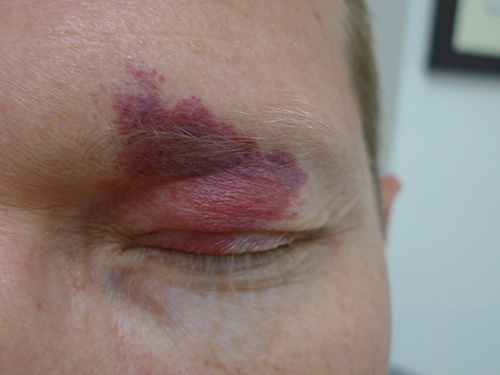Port wine stain
Port wine stains occur in 3 in 1000 neonates. These lesions are usually present at birth, and often become darker and thicker in adulthood. A typical port wine stain is a pink or red patch of skin that is well defined and flat. It usually affects only one side of the body. See here for photos of port wine stains.


Port wine stains can sometimes be difficult to differentiate from the more common naevus simplex birthmark. Unlike naevus simplex, port wine stains will not fade naturally over time. Additionally, some port wine stains may involve the mucosa and soft tissues leading to overgrowth or asymmetry of the affected body parts. Also, port wine stains affecting the forehead area on the face may be associated with underlying ocular and cerebral anomalies (Sturge-Weber syndrome).
Urgently refer to a paediatric dermatologist for port wine stains:
- on any part of the face or on cosmetically sensitive areas, for early vascular laser treatment
- involving any part of the forehead, temple or upper eyelidsDutkiewicz, 2015Waelchli, 2014 to exclude Sturge-Weber syndrome (leptomeningeal angiomatosis and glaucoma may also be present)
- associated with overgrowth or asymmetry of the affected body parts
- that appear to be growing disproportionately or increasing in number—these may be a different kind of birthmark and require specialist assessment.
The cosmetic and psychosocial impact of port wine stains can be reduced with vascular laser. Laser therapy lightens the stain by at least 50% in 80% of children. Refer early to a paediatric dermatologist, because better outcomes may be attained if laser therapy is started early in life (ideally before 6 months of age)Jeon, 2019Sabeti, 2021. Most children need at least 6 to 10 treatments, each treatment being 4 to 12 weeks apart.
